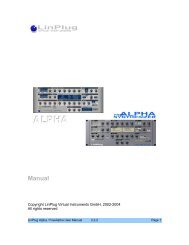Octopus Manual - LinPlug Virtual Instruments
Octopus Manual - LinPlug Virtual Instruments
Octopus Manual - LinPlug Virtual Instruments
Create successful ePaper yourself
Turn your PDF publications into a flip-book with our unique Google optimized e-Paper software.
Envelope DestinationOnce an envelope has been created, it's a good idea to set its generic typeusing the Envelope Destination popup menu. This menu sets the parametertype that the envelope modulates. Available destinations include Amplitude,Amplitude Mult., Mix Level, Mix Level Mult., Panning, Pitch, Frequency,Phase, Cutoff and Resonance. Note that setting the Envelope Destinationdoes not assign the envelope to a specific destination.Each envelope type is designed to modulate only one specific destination.Some envelopes are designed for oscillators, some for filters and others forthe sampler. Some are designed for any destination. The following listdescribes the recommended use of envelope types:• Amplitude: This envelope is designed to be used with Oscillators andthe Sampler. The envelope value is multiplied by the correspondingvalue in the Envelope Matrix and then summed with the Oscillator orSampler amplitude. It is NOT designed to modulate Filters.• Amplitude (Multiplication): This envelope is similar to the previous onehowever in this case the envelope value is multiplied with the Oscillatoror Sampler amplitude.• Mix Level, Mix multiplication: These envelopes are similar to theAmplitude envelope, but they can also be used for Oscillator and Filtermodulation. These envelope types cannot be used to modulate theSampler (because it doesn't have a general mix level parameter). Tomodulate the Sampler use an Amplitude envelope instead.• Panning: This envelope is designed for modulating Oscillators andFilters. This envelope is additive.• Pitch, Frequency, Phase: These envelopes are designed for modulatingOscillators (but not Filters). These envelopes are additive. Pitch is inSemitones and Frequency in 100Hz.• Cutoff and Resonance: These envelopes are designed only for use withfilters.All envelopes output values in the range 0.0 to 1.0 (if the +- switch is set toUnipolar) or -1.0 to +1.0 (if the +- switch is set to Bipolar). An additionalmultiplier value is available in the Envelope Matrix to set the envelopevalues to an appropriate range. Further details of these values are found inthe Envelope Matrix section of this manual.The difference between Amplitude and Amplitude Mult (Multiply) is asfollows: If the Amplitude envelope is sent to an Oscillator, the value of theAmplitude envelope is added to the oscillator amplitude. For example, if the22 <strong>Manual</strong>












